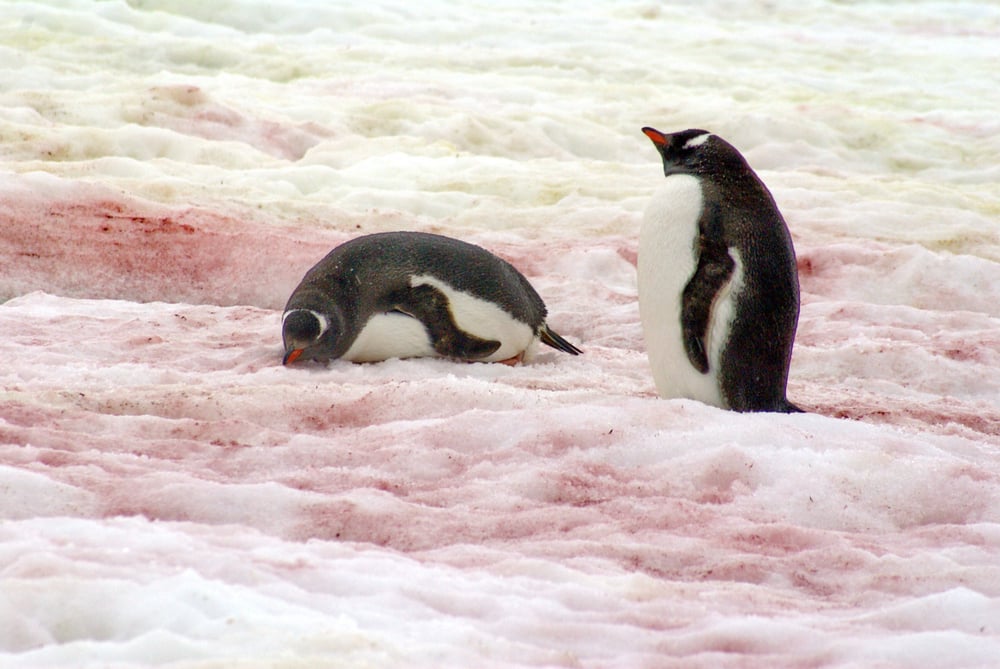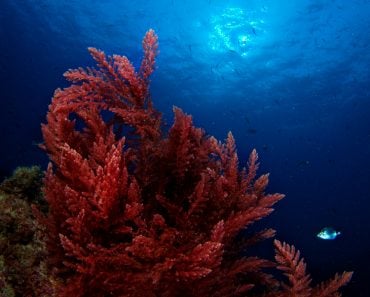Table of Contents (click to expand)
A study conducted over three years looked at how Antarctica’s green snow algae is turning parts of the landmass green. They found that the algae is a natural part of Antarctica’s ecosystem, but climate change is causing shifts in the proportions in which the algae bloom.
When we think of Antarctica, the firsts thing that comes to our mind is penguins and large areas covered with snow. Snow, which is the cleanest “white” there is. Large masses of white spread over thousands of kilometers is a pretty good description of Antarctica.
But, that legendary snow is not completely white anymore… all thanks to the algal growth!
Recommended Video for you:
What Color Is The Snow?
Research and observations conducted over the summers of the years 2017, 2018, and 2019 have led to conclusions that the Antarctic peninsula’s snow is turning green.
This is due to algal growth. These algae, even though they are individually incapable of being seen by the naked eye, are visible from space. These algae produce colonies called algal blooms, which spread over large areas.
The algal growth becomes so profound that it occupies great areas of the snow. As a result, the colony is visible as a patch (or many patches) of green on white from space.

Algae are green because of the presence of the pigment chlorophyll, which helps in photosynthesis. Not just green though, red algae have also been found on Antarctica’s snow, leaving the snow painted an ominous red!
These green and red algae are not just present ON the surface of the snow. Sometimes, they can be present below the surface of the snow such that, when the upper layer of snow melts, the algal bloom remains visible in the layers below.
Amount Of Algal Growth
Algal blooms have been found in the coastal areas of the Antarctic peninsula. The Antarctic Peninsula is the area of the continent with the most vegetation. Area-wise, Antarctica has only 0.18% of land that is free of snow. And of that, only 1.34% of the Antarctic peninsula holds vegetation.
The study found that the peninsula holds at least 1.3 × 103 tonnes of annual biomass (dry) of green snow algae. Algal blooms can spread from tens of cm2 to hundreds of m2 in area. The green snow algae have been shown to occupy approximately 1.9 km2 of the area of the peninsula.
The number of individual green snow algal blooms stands at a total of 1,679. The areas containing these colonies spanned from 300 m2 to 145,000 m2, with an average of 1,043 m2.

Field observations show that red snow algae occupy at least half of the area covered by the green snow algae. Sometimes, the red or orange algae are incorporated within green algal blooms. These can be of Sanguina species, Chloromonas polyptera, and Hydrurus species.
The Methods Deployed
This eye-opening study involved two methods to estimate the area covered by these green snow algae. Red snow algae could not be included in this study, as the wavelength at which these are detected overlaps with the one for mineral dust in the snow, making it difficult to detect red algae accurately.
Method 1: Satellite Remote Sensing
The European Space Agency’s (ESA) Sentinel 2 constellation of multispectral imaging satellites were used to estimate the distribution of the blooms. The growth of green snow algae was so profuse that these green stains on the snow were visible from outer space. Do note that this is seasonal growth, so the imaging from the satellites covers only February and March.
The multispectral imaging helped in identifying the distribution, biomass, and size of snow algal blooms across the entire Antarctic peninsula. This is the first time that satellite imaging has helped estimate the snow algal community of the peninsula region.

Method 2: In-Situ Campaigns
The scientists conducted two in-field campaigns to validate the images captured by the satellites. Data collection took place for over two field seasons. One happened at Ryder Bay, Adelaide Island (67°S) in the 2017/18 summer. The other one happened at the Fildes Peninsula, King George Island (62°S) in the 2018/19 summer.
Both field sites observed coastal snow algae growth of both green and red algae. In the December-January period, the green algae were visible between the seasonal and perennial layers of snow. However, when the snow melted in February, green algae were seen present on the older layers of snow. This layer of green algae was as thin as 9 mm.
Comparison Of The Two Methods
The Sentinel 2 imagery estimated algal biomass from 5 g to 5,791 g dry mass m−2, averaging 58 g dry mass m−2. This compared well with the average of the infield measurements, which was 30 g dry mass m−2.

What Does This Algal Growth Imply?
Conditions For Growth
These green snow algae, like other algae, require water/moisture, sunlight, and nutrients to grow. The Antarctic peninsula has recorded temperatures well above 0°C. This is good news for the algae, as their water requirement seems to be fulfilled with the snow melting.
As for the sunlight, diffuse sunlight is available due to cloud cover.
The nutrients part is perhaps the most interesting. These snow algae derive nutrition from penguin poop!
Really? Yes. The nitrogen and phosphates required for algal growth are available at places where seals, penguins, and birds excrete. These green snow algae sites were in the vicinity of elephant seal wallows, along with skuas and kelp gull nesting sites.

Of the observed algal blooms, 49% were within 100 meters of the sea, and 60% of them were within 5 kilometers of a penguin colony. Moreover, the average area and the mean cell concentration were higher at 30% of the blooms that were less than a kilometer from a penguin colony, as compared to the areas outside this radius. This implies that nutrients from the excrement of the Antarctic fauna affect the growth rates of snow algae.
For red algae though, unusual warmth is the culprit, as the scientists at a Ukrainian Research Station noted. They also shared photos of these reddish-orange blooms.
Carbon Sink
Algae photosynthesize, so such large algal growths end up taking up significant amounts of carbon from the ecosystem. Thus, they act as a short-term carbon sink (since the growth is seasonal) and help in the carbon cycling of the ecosystem.
Based on the percent carbon content of the snow algae, they act as a sink for 479 tonnes of carbon per growing season. Assuming summer to be a 122-day season with 17 hours of the daily photosynthetic period, green snow algae have net positive ecosystem production.
This sink, of course, functions only until the green snow algae aren’t dead or eaten up. After that, the carbon content would be released once again into the ecosystem.
More Global Warming
Scientists fear that such profound growth of algae can trigger more global warming, causing even more snow to melt. To better understand that, we must consider that white snow reflects most of the sunlight that falls on it.
However, as the surface of the snow darkens, it absorbs more and reflects less of the sunlight. More sunlight implies more heat trapped on the surface of the Earth. This will cause warming of the surrounding area at a faster rate, melting more snow day by day.
A Final Word
Even though Antarctica’s snow being more than just white sounds fascinating, we need to buckle up. Unusual temperatures due to global warming are the ones causing this algal growth. And algal growth, in turn, causes even more global warming. We need to push the ‘stop’ button somewhere, lest we all drown in the rapidly melting ice.
References (click to expand)
- Gray, A., Krolikowski, M., Fretwell, P., Convey, P., Peck, L. S., Mendelova, M., … Davey, M. P. (2020, May 20). Remote sensing reveals Antarctic green snow algae as important terrestrial carbon sink. Nature Communications. Springer Science and Business Media LLC.
- In Summer, Antarctic Snow Turns Green with Algae. Scientific American












